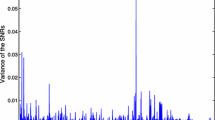Abstract
The Generalized Hidden Markov Model (GHMM) has been proved to be an excellently general probabilistic model of the gene structure of human genomic sequences. It can simultaneously incorporate different signal descriptions like splicing sites and content descriptions, for instance, compositional features of exons and introns. Enjoying its flexibility and convincing probabilistic underpinnings, we integrate some other modification of submodels and then implement a prediction program of Human Genes in DNA. The program has the capacity to predict multiple genes in a sequence, to deal with partial as well as complete genes, and to predict consistent sets of genes occurring on either or both DNA strands. More importantly, it also can perform well for longer sequences with an unknown number of genes in them. In the experiments, the results show that the proposed method has better performance in prediction accuracy than some existing methods, and over 70 % of exons can be identified exactly.
Access this chapter
Tax calculation will be finalised at checkout
Purchases are for personal use only
Similar content being viewed by others
References
Cairui, L., Changsong, Z., Guoli, S.: Recent progress in gene mapping through high-throughput sequencing technology and forward genetic approaches. Yi chuan = Hereditas/Zhongguo yi chuan xue hui bian ji 37(8), 765–776 (2015)
Burge, C., Karlin, S.: Prediction of complete gene structures in human genomic DNA. J. Mol. Biol. 268(1), 78–94 (1997)
Burset, M., Seledtsov, I.A., Solovyev, V.V.: Analysis of canonical and non-canonical splice sites in mammalian genomes. Nucleic Acids Res. 28(21), 4364–4375 (2000)
Guigó, R., et al.: Prediction of gene structure ☆. J. Mol. Biol. 226(1), 141–157 (1992)
Haussler, D., David, K., Reese, M.G., Eeckman, F.H.: A generalized hidden Markov model for the recognition of human genes in DNA. In: Proceedings of the International Conference on Intelligent Systems for Molecular Biology, St. Louis (1996)
Stanke, M., Waack, S.: Gene prediction with a hidden Markov model and a new intron submodel. Bioinformatics 19(suppl 2), 215–225 (2003)
Fickett, J.W.: Finding genes by computer: the state of the art. Trends Genet. 12(8), 316–320 (1996)
Krogh, A., Mian, I.S., Haussler, D.: A hidden Markov model that finds genes in E. coli DNA. Nucleic Acids Res. 22(22), 4768–4778 (1994)
Salzberg, Steven L., D. B. Searls, and S. Kasif. “Computational methods in molecular biology.” Computational Methods in Molecular Biology49.2(1999):191-192
Ryan, M.S., Nudd, G.R.: The viterbi algorithm. Warwick Res. Rep. Rr 37(2), 160–163 (1993)
Majoros, W.H., et al.: Efficient decoding algorithms for generalized hidden Markov model gene finders. BMC Bioinform. 6(2), 8–16 (2005)
Zhang, M.Q., Marr, T.G.: A weight array method for splicing signal analysis. Comput. Appl. Biosci. Cabios 9(5), 499–509 (1993)
Salzberg, S.L., et al.: Microbial gene identification using interpolated Markov models. Nucleic Acids Res. 26(2), 544–548 (1998)
Acknowledgement
This article is partly supported by the Shenzhen Municipal Science and Technology Innovation Council (Nos. JCYJ20140904154645958).
Author information
Authors and Affiliations
Corresponding author
Editor information
Editors and Affiliations
Rights and permissions
Copyright information
© 2016 Springer International Publishing AG
About this paper
Cite this paper
Guo, R., Yan, K., He, W., Zhang, J. (2016). The Prediction of Human Genes in DNA Based on a Generalized Hidden Markov Model. In: You, Z., et al. Biometric Recognition. CCBR 2016. Lecture Notes in Computer Science(), vol 9967. Springer, Cham. https://doi.org/10.1007/978-3-319-46654-5_82
Download citation
DOI: https://doi.org/10.1007/978-3-319-46654-5_82
Published:
Publisher Name: Springer, Cham
Print ISBN: 978-3-319-46653-8
Online ISBN: 978-3-319-46654-5
eBook Packages: Computer ScienceComputer Science (R0)




